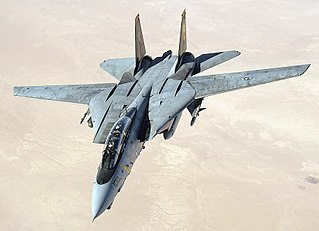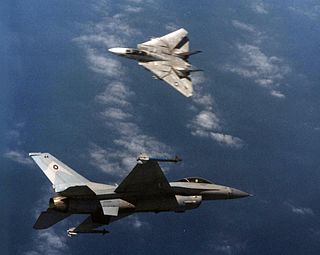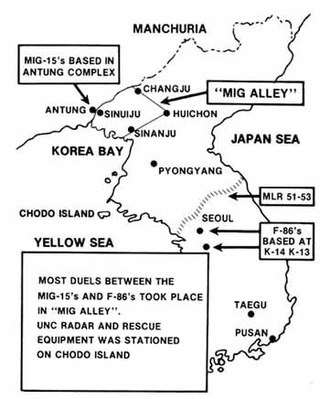
The Grumman F-14 Tomcat is an American carrier-capable supersonic, twin-engine, two-seat, twin-tail, variable-sweep wing fighter aircraft. The Tomcat was developed for the United States Navy's Naval Fighter Experimental (VFX) program after the collapse of the General Dynamics-Grumman F-111B project. A large and well-equipped fighter, the F-14 was the first of the American Teen Series fighters, which were designed incorporating air combat experience against MiG fighters during the Vietnam War.

The Gulf War was a 1990–1991 armed campaign waged by a 39-country military coalition in response to the Iraqi invasion of Kuwait. Spearheaded by the United States, the coalition's efforts against Iraq were carried out in two key phases: Operation Desert Shield, which marked the military buildup from August 1990 to January 1991; and Operation Desert Storm, which began with the aerial bombing campaign against Iraq on 17 January 1991 and came to a close with the American-led Liberation of Kuwait on 28 February 1991.

A dogfight, or dog fight, is an aerial battle between fighter aircraft conducted at close range. Modern terminology for air-to-air combat is air combat manoeuvring (ACM), which refers to tactical situations requiring the use of individual basic fighter maneuvers (BFM) to attack or evade one or more opponents. This differs from aerial warfare, which deals with the strategy involved in planning and executing various missions.
This is a list of aviation-related events from 1991.

Tonopah Test Range Airport, at the Tonopah Test Range is 27 NM southeast of Tonopah, Nevada, and 140 mi (230 km) northwest of Las Vegas, Nevada. It is a major airfield with a 12,000 ft × 150 ft runway, instrument approach facilities, and nighttime illumination. The facility has over fifty hangars and an extensive support infrastructure.
The Grumman F-14 Tomcat has served with the United States Navy and The Imperial Iranian Air Force (IIAF), then Islamic Republic of Iran Air Force (IRIAF) after 1979 revolution. It operated aboard U.S. aircraft carriers from 1974 to 2006 and remains in service with Iran. In-depth knowledge of its service with Iran is relatively limited.

"MiG Alley" was the name given by United Nations (UN) pilots during the Korean War to the northwestern portion of North Korea, where the Yalu River empties into the Yellow Sea. It was the site of numerous dogfights between UN fighter pilots and their opponents from North Korea and the People's Republic of China. Soviet-built Mikoyan-Gurevich MiG-15 were the aircraft used during most of the conflict, and the area's nickname was derived from them. It was the site of the first large-scale jet-vs.-jet air battles, with the North American F-86 Sabre.

The 22nd Fighter Squadron, sometimes written as 22d Fighter Squadron, is an inactive United States Air Force unit. It was last assigned to the 52nd Operations Group and stationed at Spangdahlem Air Base, Germany.

The 421st Fighter Squadron is part of the 388th Fighter Wing at Hill Air Force Base, Utah. It operates the Lockheed Martin F-35A aircraft conducting air superiority missions. The squadron is one of the most decorated fighter squadrons in the United States Air Force, being awarded three Presidential Unit Citations and seven Air Force Outstanding Unit Awards for Valor in Combat.

The Gulf War of 1990–1991 included air campaign, as the air forces of the coalition carried an extensive aerial bombing campaign from 17 January 1991 to 23 February 1991 against Iraq. Spearheaded by the United States, the coalition flew over 100,000 sorties, dropping 88,500 tons of bombs, widely destroying military and civilian infrastructure. The air campaign was commanded by United States Air Force (USAF) lieutenant general Chuck Horner, who briefly served as Commander-in-Chief—Forward of U.S. Central Command while general Norman Schwarzkopf was still in the United States. The British air commanders were Air Vice-Marshal Andrew Wilson and Air Vice-Marshal Bill Wratten. The air campaign had largely finished by 23 February 1991 when the coalition invasion of Kuwait took place.

Air-to-air combat is the engagement of combat aircraft in warfare in which primarily fixed-wing aircraft attempt to destroy enemy aircraft using guns, rockets and missiles. The Korean War saw the greatest amount of air-to-air combat since World War II. During the war the United States claimed to have shot down around 700 fighters. After the war the U.S. Air Force reviewed its figures in an investigation code-named Sabre Measure Charlie and downgraded the kill ratio of the North American F-86 Sabre against the Mikoyan-Gurevich MiG-15 by half from 14:1 to 7:1. One of the factors inflating US numbers was that most dogfights took place over enemy-controlled area. The only way to confirm kills was through gun camera photography. USAF pilots were credited with a kill if the gun camera showed their guns striking the enemy aircraft even if no one actually saw it go down. However, Soviet Air Force kill claims were also highly exaggerated, based upon inherent flaws in their film grading procedures. For instance, the S-13 gun camera was not aligned with either the gunsight or either cannons' ballistics. It ran only while the firing buttons were depressed. Film graders commonly included unit commanders and political commisars who would confirm a "kill"—sometimes even if one had not been claimed by a pilot—when the camera's crosshairs touched the target for two movie frames. During the first 16 months of combat Soviet V-VS units claimed 218 F-86s destroyed when only 36 had been lost. This results in a 600 per cent inflation rate in victory credits over actual Sabres destroyed. However, these figures are complicated by the fact that the Americans routinely attributed combat losses to landing accidents and other causes.
The General Dynamics F-16 Fighting Falcon has served the United States and the air arms of 25 other nations. Over 4,400 F-16s have been sold.
During the 1991 Gulf War and subsequent operations in no-fly zones over Iraq, Coalition air forces faced the Iraqi Air Force (IQAF), the fourth largest air force in the world at the time. In the opening days of the war, many air-to-air engagements occurred, between Iraqi interceptors and a variety of different Coalition aircraft.
Cesar Antonio Rodriguez is a former United States Air Force (USAF) officer and pilot who served from 1981 to 2006. With three air-to-air combat victories, he joined USAF pilots Thomas Dietz, Robert Hehemann and Robert Wright as the closest to becoming a flying ace of any U.S. pilot since the Vietnam War. Rodriguez scored his kills in an F-15 Eagle - the first two kills in 1991, during the first Gulf War, against a Mikoyan MiG-29 and a Mikoyan MiG-23 of the Iraqi Air Force, and his third kill came against a MiG-29 of the Yugoslav air force during the 1999 NATO bombing of Yugoslavia.
Operation Samurra was an operation by the Iraqi Air Force (IQAF) during the Gulf War to decisively engage McDonnell Douglas F-15C Eagle fighters from the United States Air Force (USAF) using Mikoyan-Gurevich MiG-25 interceptors, and break the "wall" of F-15s that the Coalition had established along Iraq's border with Iran. It demonstrated the last true offensive operation of the IQAF before grounding their air assets in an attempt to preserve them for future use. Through careful planning and coordination, two MiG-25 jets successfully caught two USAF F-15 fighters off guard and engaged them in a dogfight. After several minutes of aerial maneuvering and several fired missiles, the Iraqi jets returned to Tammuz Air Base undamaged, and the F-15s returned to Saudi Arabia, albeit with one damaged.








